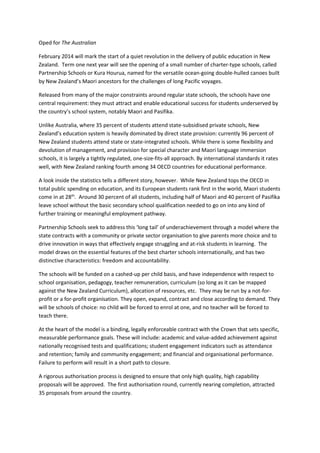
0719 article for The Australian
- 1. Oped for The Australian February 2014 will mark the start of a quiet revolution in the delivery of public education in New Zealand. Term one next year will see the opening of a small number of charter-type schools, called Partnership Schools or Kura Hourua, named for the versatile ocean-going double-hulled canoes built by New Zealand’s Maori ancestors for the challenges of long Pacific voyages. Released from many of the major constraints around regular state schools, the schools have one central requirement: they must attract and enable educational success for students underserved by the country’s school system, notably Maori and Pasifika. Unlike Australia, where 35 percent of students attend state-subsidised private schools, New Zealand’s education system is heavily dominated by direct state provision: currently 96 percent of New Zealand students attend state or state-integrated schools. While there is some flexibility and devolution of management, and provision for special character and Maori language immersion schools, it is largely a tightly regulated, one-size-fits-all approach. By international standards it rates well, with New Zealand ranking fourth among 34 OECD countries for educational performance. A look inside the statistics tells a different story, however. While New Zealand tops the OECD in total public spending on education, and its European students rank first in the world, Maori students come in at 28th . Around 30 percent of all students, including half of Maori and 40 percent of Pasifika leave school without the basic secondary school qualification needed to go on into any kind of further training or meaningful employment pathway. Partnership Schools seek to address this ‘long tail’ of underachievement through a model where the state contracts with a community or private sector organisation to give parents more choice and to drive innovation in ways that effectively engage struggling and at-risk students in learning. The model draws on the essential features of the best charter schools internationally, and has two distinctive characteristics: freedom and accountability. The schools will be funded on a cashed-up per child basis, and have independence with respect to school organisation, pedagogy, teacher remuneration, curriculum (so long as it can be mapped against the New Zealand Curriculum), allocation of resources, etc. They may be run by a not-for- profit or a for-profit organisation. They open, expand, contract and close according to demand. They will be schools of choice: no child will be forced to enrol at one, and no teacher will be forced to teach there. At the heart of the model is a binding, legally enforceable contract with the Crown that sets specific, measurable performance goals. These will include: academic and value-added achievement against nationally recognised tests and qualifications; student engagement indicators such as attendance and retention; family and community engagement; and financial and organisational performance. Failure to perform will result in a short path to closure. A rigorous authorisation process is designed to ensure that only high quality, high capability proposals will be approved. The first authorisation round, currently nearing completion, attracted 35 proposals from around the country.
- 2. The framework of the model and the commitment to pilot it within the current three-year Parliamentary term was the central feature of the governing National Party’s 2011 confidence and supply agreement with the ACT Party, a minor classical liberal party with currently just one member in the House. Not surprisingly, development of the fledgling policy and its progress through Parliament has not been without controversy. Most vociferous has been the opposition of New Zealand’s powerful teacher unions, who see the initiative as undermining union control over teachers’ collective agreements and a direct assault on the country’s state education system. Interestingly, when Sweden moved some 20 years ago to introduce a form of charter school, now a highly successful mainstream feature of its school network, their teacher unions did not oppose it. Instead they saw it as an opportunity for teachers to gain professionally from more alternatives and innovation in education. Subsequent surveys have shown this to be true, with significantly higher teacher satisfaction rates for teachers in ‘free’ schools, compared with their regular state school counterparts. The most important factor countering opposition to the introduction of Partnership Schools has been a clear demonstration of support for the initiative from the communities around the country for whom it was designed. The Iwi Education Authority, a leading voice of Maori education representing tribal Maori immersion schools, gave it their “total and unequivocal support”. Appearing before the Parliamentary Select Committee hearing submissions on the legislative amendment, Iwi Education Authority Chair Dr Toby Curtis noted the “consistently poor status quo results for Maori … with no respite in sight from an unresponsive and unempathetic mainstream system. Kura Hourua [Partnership Schools] can be a circuit breaker with us, an agent of desperately needed change.” Details of the first group of Partnership Schools to be established will be announced shortly by Minister of Education Hon Hekia Parata. Catherine Isaac is chair of the Government-appointed Partnership Schools/Kura Hourua Authorisation Board and chaired the Government working group that developed the policy.